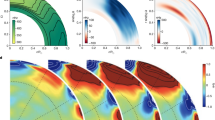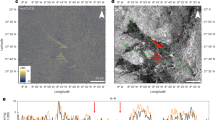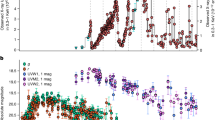Abstract
LIGHTNING is known to occur in the atmospheres of Earth and Jupiter1, and there is strong evidence of lightning on Saturn2 and Uranus3. Based on its extensive atmosphere, the presence of aerosols and the deposition of significant amounts of solar energy at its surface, it has been calculated that Saturn's largest moon, Titan, may produce lightning with an energy dissipation rate somewhat less than that at Earth4. An opportunity to search for evidence of lightning at Titan occurred during the Voyager 1 encounter with Saturn on 12 November 1980, when the spacecraft passed within 4,394 km of Titan's cloud tops. Because optically thick cloud and haze layers prevented lighting detection at optical wavelengths, we have searched for lightning-radiated signals (spherics) at radio wavelengths using the planetary radioastronomy instrument5 aboard Voyager 1. Given the maximum ionosphere density6,7 of ∼3 × 103cm−3, lightning spherics should be detectable above an observing frequency of 500 kHz. Failing to find any evidence for lightning-associated spherics, we infer an upper limit to the total energy per flash in Titan lightning of ∼106 J, or about a thousand times weaker than that typical of terrestrial lightning. The level of lightning activity on Titan has implications for the production of certain hydrocarbons in its atmosphere and for the design of instruments on spacecraft such as Cassini, which is scheduled to arrive at Saturn in 2002.
This is a preview of subscription content, access via your institution
Access options
Subscribe to this journal
Receive 51 print issues and online access
$199.00 per year
only $3.90 per issue
Buy this article
- Purchase on Springer Link
- Instant access to full article PDF
Prices may be subject to local taxes which are calculated during checkout
Similar content being viewed by others
References
Smith, B. A. et al. Science 204, 951–972 (1979).
Kaiser, M. L., Connerney, J. E. P. & Desch, M. D. Nature 303, 50–53 (1983).
Zarka, P. & Pedersen, B. M. Nature 323, 605–608 (1986).
Borucki, W. J., McKay, C. P. & Whitten, R. C. Icarus 60, 260–273 (1984).
Warwick, J. W. et al. Space Sci. Rev. 21, 309–319 (1977).
Strobel, D. F. & Shemansky, D. E. J. geophys. Res. 87, 1361–1368 (1982).
Lindal, G. F. et al. Icarus 53, 348–363 (1983).
Kaiser, M. L., Desch, M. D. & Lecacheux, A. Nature 292, 731–733 (1981).
Homer, F. Advances in Radio Research Vol. 2 (ed. Saxon, J. A.) 121–204 (Academic, New York, 1964).
Taylor, W. L. J. Res. natn. Bur. Stand. 67D, 539–550 (1963).
Lanzerotti, L. J. et al. J. geophys. Res. 94, 13221–13227 (1989).
Kotaki, M. & Katoh, C. J. atmos. terr. Phys. 45, 833–847 (1983).
LeVine, D. M. & Meneghini, R. Radio Sci. 13, 801–809 (1978).
Vonnegut, B. Met. Monogr. 5, 224–241 (1963).
Smith, G. R. et al. J. geophys. Res. 87, 1351–1359 (1982).
Borucki, W. J. et al. Icarus 72, 604–622 (1987).
Ratcliffe, J. A. The Magnetoionic Theory and its Applications to the Ionosphere (Cambridge University Press, 1962).
Zarka, P. Astr. Astrophys. 146, L15–L18 (1985).
Borucki, W. J. & Chameides, W. L. Rev. Geophys. Space Phys. 22, 363–372 (1984).
Yung, Y. L., Allen, M. & Pinto, J. P. Astrophys. J. Suppl. Ser. 55, 465–506 (1984).
Borucki, W. J. et al. Icarus 76, 125–134 (1988).
Rinnert, K. J. geophys. Res. 90, 6225–6237 (1985).
Author information
Authors and Affiliations
Rights and permissions
About this article
Cite this article
Desch, M., Kaiser, M. Upper limit set for level of lightning activity on Titan. Nature 343, 442–444 (1990). https://doi.org/10.1038/343442a0
Received:
Accepted:
Issue Date:
DOI: https://doi.org/10.1038/343442a0
This article is cited by
-
Ground-Based and Space-Based Radio Observations of Planetary Lightning
Space Science Reviews (2008)
-
Updated Review of Planetary Atmospheric Electricity
Space Science Reviews (2008)
-
Atmospheric Electrification in the Solar System
Surveys in Geophysics (2006)
-
Radio Wave Emission from the Outer Planets Before Cassini
Space Science Reviews (2005)
-
The Cassini Radio and Plasma Wave Investigation
Space Science Reviews (2004)
Comments
By submitting a comment you agree to abide by our Terms and Community Guidelines. If you find something abusive or that does not comply with our terms or guidelines please flag it as inappropriate.



